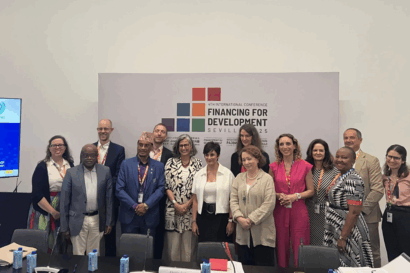The Ivorian government is under pressure to raise its tax-to-GDP ratio – which stood at around 11.9% of GDP in 2022 – to meet the 20% benchmark set by the West African Monetary and Economic Union. IMF loans supporting the country’s National Development Plan 2021-2025 add to this urgency as they call for improvements in public finance sustainability and domestic resource mobilisation. To help with these financial challenges, property taxes have been explicitly identified as a key revenue source.
Property tax: an untapped revenue source
While property taxes represent a significant resource for helping local authorities deliver more and better public services, they remain largely untapped in many countries. Indeed, leveraging property taxes more effectively requires not only substantial political will but also administrative or technical reforms, all part of a comprehensive strategy that aims to address fiscal equity and taxpayer perceptions to enhance voluntary compliance, beyond immediate revenue gains. But this approach is not necessarily straightforward.
The case of Côte d’Ivoire, where the government has implemented wide-ranging reforms to boost property tax revenues, offers valuable insights. This blog, based on interview data collected in 2023, examines how robust political will has propelled reforms but how urgency has narrowed the focus primarily on short-term revenue targets, potentially undermining investments in more sustainable, long-term strategies.
Political will for property tax in Côte d’Ivoire
Strong political will has translated into high-level pressure on the central-government General Tax Directorate (DGI) – and specifically on the Cadaster Directorate (DCAD) within the DGI, which handles property tax. The DCAD was tasked with meeting ambitious annual targets, which become significantly more ambitious each year. This pressure cascades down from the central DCAD office in Abidjan to regional directors, who are summoned multiple times a year to report on their performance.
The drive to raise property tax revenues has taken shape through several commitments to important legislative and administrative reforms, setting various initiatives in motion. For instance, near-constant field operations are conducted at the regional level to expand and update property registers. In parallel, different DCAD-led projects seek to improve database quality and access owner information. Significant investments are also made from the DGI’s annual budget for cadaster management, database updates, tax collection, staff training, and Information and Communications Technology (ICT) enhancements. The digitalisation of various processes, including online payment systems, is also underway. Administrative openness to piloting new operational procedures – sometimes beyond the current legal framework, such as taxing buildings with unknown owners – together with planned legal amendments, reflect a strong political will to confront potential political resistance. These efforts have yielded dividends, as evidenced by the year-on-year increase in property tax revenues, often exceeding 10% since 2018 according to DGI data.
Pitfalls of ambitious, short-term, revenue-focused tax targets
The intense pressure on the tax administration has prioritised meeting immediate tax revenue targets sometimes at the expense of long-term considerations relating to tax equity, administrative efficiency, and inter-institutional cooperation.
Equity
The reform of the property valuation system which seeks to shift from administrative values largely set by tax agents to market values set by expert commissions seems primarily driven by the potential to increase revenues. However, it fails to address existing valuation inequities. The valuation formula considers the number of rooms in a property rather than its surface area, which likely negatively impacts low-income households residing in small, multi-room properties. Moreover, the coefficients for residency zones used in the valuation formula may fail to be sufficiently fine grained and to adequately reflect the varying values of individual properties within the same zone. Addressing equity in property valuation is crucial for encouraging voluntary tax compliance and establishing a sustainable system.
Additionally, the strong pressure on property owners already in the tax base – some of whom are required to pay arrears dating back many years – may help meet short-term tax collection targets but places a disproportionate burden on a narrow group of taxpayers. This approach can be perceived as coercive and unfair, potentially deterring taxpayers in the long run. A more lenient approach, with a focus on fairness between all property owners, would progressively build taxpayer habits and trust, yielding better long-term results.
Cost-effectiveness
The focus on immediate financial results may divert attention from investing in cost-effective strategies upfront. For example, efficiency in property identification could be enhanced by better utilising GIS technology to create unique identifiers and by using satellite imagery instead of costly aerial one.
With dedicated technical, assessment and collection offices established in each region, property tax mobilisation is administratively costly, generating only about 5% of the revenue levied by the DGI (2019 figures). Consequently, the DCAD faces pressure to reduce costs, yet this has remained a secondary objective compared to increasing tax revenue. Investing in cost-effective reforms may initially slow revenue growth but is critical for establishing a sustainable system in the long run.
Coordination
A wide array of projects is undertaken at different levels to raise property tax revenues, but inter-institutional cooperation often falls short. This may be partly due to each institution’s need to push ahead without dedicating sufficient time to coordinate efforts. As a result, property mapping and registration follow a fragmented approach, even leading to geographical overlap in some cases.
Lack of coordination is further reflected in the siloed implementation of digitalisation projects. While each administrative unit involved in property tax administration has initiated digitalisation of certain processes, more streamlined planning and resource allocation are needed to integrate these systems. Strengthening coordination and information-sharing between administrative units is essential to ensure the effectiveness and efficiency of property tax administration.
The pressure to meet performance targets has also led to administrative malpractice. For instance, in efforts to boost registration figures, some agents from the property tax base units attach properties to unrelated plots when the correct plot number is unavailable. Consequently, tax collection agents are unable to locate the properties, preventing them from levying taxes.
Toward a more sustainable system of property tax administration
Political will and the capacity to enforce reforms are essential for improving property tax mobilisation. However, the case of Côte d’Ivoire illustrates that political pressure alone is insufficient and may lead to adverse long-term effects.
Examining the reforms alongside performance figures reveals undeniable progress in property tax mobilisation in Côte d’Ivoire. However, these very high and immediate revenue targets appear to partly detract from setting up a sustainable system of property tax administration – which falls in line with evidence from other low- and middle-income countries.
To establish a more sustainable system, decision-makers in Côte d’Ivoire should reconsider how they set objectives for the DGI. A more sustainable approach might involve first setting strategically chosen output objectives, such as making IT system integration operational within a year, while setting realistic outcome objectives regarding tax base expansion and revenue generation. Moving beyond sole revenue targets while focusing on equity, cost-effectiveness, and cross-agency coordination is crucial for developing an effective property tax administration system in the long term.



